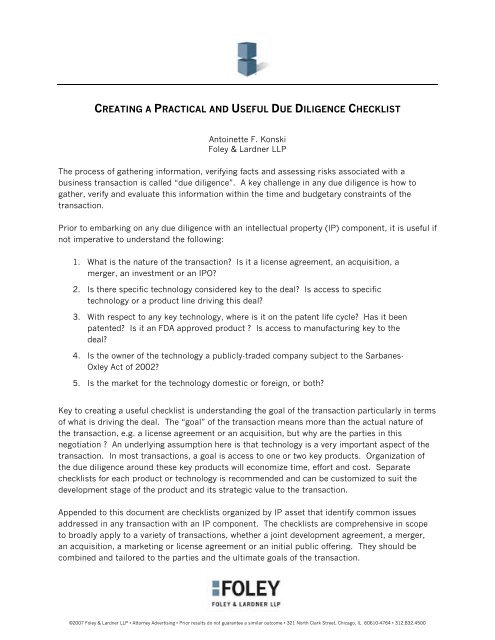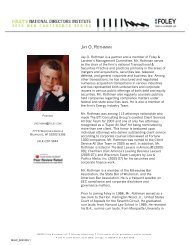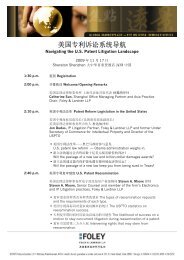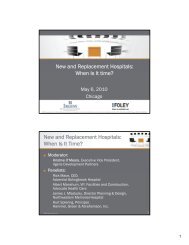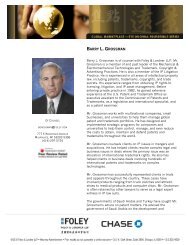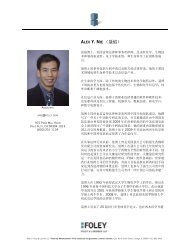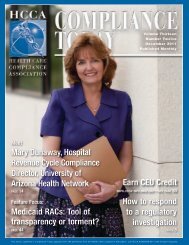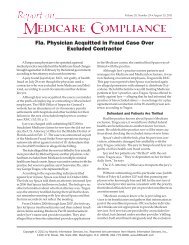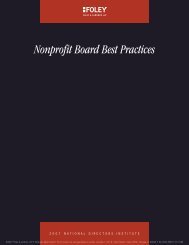creating a practical and useful due diligence checklist
creating a practical and useful due diligence checklist
creating a practical and useful due diligence checklist
Create successful ePaper yourself
Turn your PDF publications into a flip-book with our unique Google optimized e-Paper software.
CREATING A PRACTICAL AND USEFUL DUE DILIGENCE CHECKLIST<br />
Antoinette F. Konski<br />
Foley & Lardner LLP<br />
The process of gathering information, verifying facts <strong>and</strong> assessing risks associated with a<br />
business transaction is called “<strong>due</strong> <strong>diligence</strong>”. A key challenge in any <strong>due</strong> <strong>diligence</strong> is how to<br />
gather, verify <strong>and</strong> evaluate this information within the time <strong>and</strong> budgetary constraints of the<br />
transaction.<br />
Prior to embarking on any <strong>due</strong> <strong>diligence</strong> with an intellectual property (IP) component, it is <strong>useful</strong> if<br />
not imperative to underst<strong>and</strong> the following:<br />
1. What is the nature of the transaction? Is it a license agreement, an acquisition, a<br />
merger, an investment or an IPO?<br />
2. Is there specific technology considered key to the deal? Is access to specific<br />
technology or a product line driving this deal?<br />
3. With respect to any key technology, where is it on the patent life cycle? Has it been<br />
patented? Is it an FDA approved product ? Is access to manufacturing key to the<br />
deal?<br />
4. Is the owner of the technology a publicly-traded company subject to the Sarbanes-<br />
Oxley Act of 2002?<br />
5. Is the market for the technology domestic or foreign, or both?<br />
Key to <strong>creating</strong> a <strong>useful</strong> <strong>checklist</strong> is underst<strong>and</strong>ing the goal of the transaction particularly in terms<br />
of what is driving the deal. The “goal” of the transaction means more than the actual nature of<br />
the transaction, e.g. a license agreement or an acquisition, but why are the parties in this<br />
negotiation ? An underlying assumption here is that technology is a very important aspect of the<br />
transaction. In most transactions, a goal is access to one or two key products. Organization of<br />
the <strong>due</strong> <strong>diligence</strong> around these key products will economize time, effort <strong>and</strong> cost. Separate<br />
<strong>checklist</strong>s for each product or technology is recommended <strong>and</strong> can be customized to suit the<br />
development stage of the product <strong>and</strong> its strategic value to the transaction.<br />
Appended to this document are <strong>checklist</strong>s organized by IP asset that identify common issues<br />
addressed in any transaction with an IP component. The <strong>checklist</strong>s are comprehensive in scope<br />
to broadly apply to a variety of transactions, whether a joint development agreement, a merger,<br />
an acquisition, a marketing or license agreement or an initial public offering. They should be<br />
combined <strong>and</strong> tailored to the parties <strong>and</strong> the ultimate goals of the transaction.<br />
©2007 Foley & Lardner LLP • Attorney Advertising • Prior results do not guarantee a similar outcome • 321 North Clark Street, Chicago, IL 60610-4764 • 312.832.4500
To that end, the following text attempts to place the items listed on the <strong>checklist</strong>s into the broader<br />
context of an IP <strong>due</strong> <strong>diligence</strong>.<br />
The Intellectual Property<br />
Intellectual property includes patents, trademarks, copyrights, trade secrets <strong>and</strong> know how.<br />
Thus, an IP <strong>due</strong> <strong>diligence</strong> may include a review of all of these forms of IP. Patents <strong>and</strong> trade<br />
secrets are the forms of IP that are usually considered most important. Thus, the assessment of<br />
the patents, trade secrets <strong>and</strong> ancillary know-how will consume a lion’s share of the resources<br />
allocated in the <strong>diligence</strong>. For transactions involving commercially available products or soon to<br />
be marketed products, the <strong>due</strong> <strong>diligence</strong> may extend to a review of regulatory filings <strong>and</strong><br />
manufacturing facilities. Further complexity <strong>and</strong> analysis is required for publicly traded<br />
companies to ensure compliance with The Sarbanes-Oxley Act of 2002.<br />
Patent <strong>due</strong> <strong>diligence</strong> typically involves two core inquiries: (a) the nature <strong>and</strong> strength of<br />
the patent filings as a right to exclude; <strong>and</strong> (b) whether any third party that can exclude the<br />
practice of the IP or the making or selling of a product.<br />
Evaluating the Right to Exclude<br />
Evaluation of the patent portfolio can be divided into three or more task-based segments: 1)<br />
cataloguing <strong>and</strong> verifying ownership of the IP; 2) assessment of the scope <strong>and</strong> validity of any<br />
patent claim; <strong>and</strong> 3) freedom to make, use or sell the technology without impeding on the valid<br />
rights of other patent holders.<br />
An evaluation of the right to exclude necessarily requires a cataloging of the patent filings <strong>and</strong> an<br />
evaluation of the merits of those pending <strong>and</strong> issued patents. While it is <strong>useful</strong> to start with a<br />
patent status report provided by the patent owner or licensee, this information should be verified<br />
either by a review of the actual patent filings or by records available from publicly available<br />
databases.<br />
Since the right to exclude is limited to the country in which each patent is granted, cataloging of<br />
the patent filings should verify the individual status of each patent application by country (e.g., is<br />
the patent pending, issued, or has it lapsed ?) <strong>and</strong> the claimed subject matter. Also, an<br />
evaluation of the patent claim as compared to any potential or present commercial product in the<br />
markets where the product is to be sold or made is key to ensuring that the patent provides the<br />
expected right to exclude.<br />
Ownership of a patent resides by right in the inventor or inventors. Therefore, companies or<br />
universities can only obtain patent rights by assignment of these rights from the inventors. In<br />
most instances, the owner is the assignee of the patent rights either by an express patent<br />
assignment or by an implied obligation to assign those rights under an employment agreement.<br />
2
Verification that a good faith effort was made to identify all inventors on the patent <strong>and</strong> the<br />
identification of potential inventorship challenges can start by searching for inventor-authored<br />
technical publications <strong>and</strong> confirming the contribution, if any, of any author who was not named<br />
in the patent filings as a joint inventor, or vice versa.<br />
No matter what the scope of the <strong>diligence</strong>, it is imperative that the claims of any patent filings be<br />
compared against the commercial embodiment or product. While “broad” claims provide an<br />
extra layer of protection against competitors <strong>and</strong> copiers, concisely drafted claims that protect<br />
the commercial embodiment(s), especially if present in published applications, are more likely to<br />
withst<strong>and</strong> challenge <strong>and</strong> may provide the basis for added damages if <strong>and</strong> when the patent is<br />
enforced. Therefore, it is <strong>useful</strong> at the onset to identify each claim that covers specifically <strong>and</strong><br />
generically any commercial product <strong>and</strong> how the product is made <strong>and</strong> used. Where the<br />
technology has been commercialized, evaluation of patent markings on the product <strong>and</strong><br />
accompanying packaging must also be investigated <strong>and</strong> confirmed.<br />
The substance of the examination of any patent filing should be reviewed for obvious omissions<br />
<strong>and</strong> missteps, such as failure to timely file an application prior to publication, disclosure or sale of<br />
the invention, failure to timely file an international application to obtain the benefit of the Paris<br />
Convention, failure to cite to the patent office(s) prior art, especially that cited by patent offices,<br />
<strong>and</strong> the timely payment of maintenance fees <strong>and</strong> annuities. While there is a one year grace period<br />
for disclosing one’s own invention prior to filing the patent application in the United States, most<br />
foreign countries do not have such a grace period <strong>and</strong> adhere to a strict novelty st<strong>and</strong>ard. Stated<br />
another way, in such countries, any application that claims the invention must be filed prior to any<br />
non-confidential publication of that invention. Therefore, a public disclosure of the invention prior<br />
to filing of the patent application negates the patent rights in most foreign countries. 1<br />
Invention disclosures should also be obtained <strong>and</strong> reviewed to determine if the inventors have<br />
identified what they consider to be the most relevant prior art. Communication of this information<br />
to the patent offices that have an disclosure obligation should be confirmed when reviewing the<br />
file history of any patent family.<br />
Third-party <strong>and</strong> post-grant challenges to patent validity, if any, should also be identified <strong>and</strong><br />
evaluated for merit. This information may be obtained from commercial databases but is<br />
typically obtained by interviewing the attorney or agent who is responsible for filing, prosecuting<br />
<strong>and</strong> maintaining the patents.<br />
While it would be ideal to evaluate the validity of every claim of every patent in the portfolio, in<br />
most instances such an undertaking would exceed the budget allocated to the <strong>diligence</strong>. Thus,<br />
1 Note that electronic disclosures are treated the same as paper disclosures so pre-publication transmittals over<br />
the internet to the public will also impede the ability to obtain patent protection.<br />
3
the patent claims considered to most cover the commercial embodiments should be reviewed for<br />
novelty, obviousness <strong>and</strong> support for meeting the written description requirement. This involves a<br />
search <strong>and</strong> review of the “prior art” (prior patents, publications, public disclosures, etc.) to<br />
determine if the patent claims are novel <strong>and</strong> non-obvious in each country where an application has<br />
been filed. Priority should be given to those countries of greatest commercial interest to conserve<br />
time <strong>and</strong> resources.<br />
The patent claims also should be evaluated in light of the evolving case law in the United States<br />
<strong>and</strong> foreign countries. For example, the concept of whether a claim is “novel” is not always<br />
straightforward in the biological sciences where properties of a prior art composition may<br />
inherently anticipate later filed patent claims. Moreover, the obviousness st<strong>and</strong>ard applied in the<br />
United States, while similar to the concept of inventive step in foreign jurisdictions; is not<br />
necessarily its equivalent. Thus, where foreign patent rights are key to the transaction, it may be<br />
prudent to engage foreign patent counsel for a validity search <strong>and</strong> opinion that independently<br />
considers the most recent applicable law in that country.<br />
The requirement that patent claims be adequately enabled throughout their scope <strong>and</strong> be<br />
adequately described in the patent specification, including any priority patent application, is<br />
evolving <strong>and</strong> of more concern to patent practitioners in the United States <strong>and</strong> abroad than it has<br />
been in the past. Thus, the evaluation of the patent specification <strong>and</strong> the number of working<br />
examples in support of the claims should be separately reviewed <strong>and</strong> analyzed.<br />
The U.S. patent system is unique in requiring that each patent holder identify the best mode to<br />
practice an invention claimed in a patent. This additional requirement may create a trap for the<br />
unwary foreign patent applicant if the U.S. patent application was prepared only to meet non-U.S.<br />
st<strong>and</strong>ards. Thus, the patent claims <strong>and</strong> supporting specification should be analyzed to determine<br />
if the best mode has been disclosed.<br />
Prior to delving into any specific FDA or other regulatory issue, whether or not patent term<br />
extension was applied for <strong>and</strong> obtained should be investigated <strong>and</strong> confirmed for patents covering<br />
an approved product or device.<br />
Freedom to Operate<br />
The “freedom to operate” analysis is an assessment of whether the making, using, sale or<br />
importation of a product will infringe third party patents. The inquiry is more complex when<br />
pending claims are published yet not issued, so the inquiry not only requires construction of the<br />
claims <strong>and</strong> infringement analysis, but also estimation of whether the published claim(s) will issue.<br />
Evolving application of infringement under the doctrine of equivalents only adds to the complexity<br />
<strong>and</strong> cost of this analysis.<br />
4
It is important at the outset of the <strong>diligence</strong> to request the results of any pre-existing infringement<br />
or freedom to operate opinions, <strong>and</strong> to determine whether the potential partner has received<br />
notice from a patent holder that they may be at risk of infringing another’s patent.<br />
Freedom to operate or product clearance searches may have been conducted that identify<br />
potential blocking patents. It is not uncommon for companies to have obtained opinions that<br />
identify <strong>and</strong> address the potentially blocking patents. If possible, copies of these opinions should<br />
be obtained <strong>and</strong> evaluated in terms of continuing evolving case law.<br />
With respect to the infringement of an issued U.S. Patent, all subsections of 35 U.S.C. § 271<br />
should be considered, e.g., direct infringement, contributory infringement <strong>and</strong> inducement to<br />
infringe. Importation of a product made by a process patented in the United States also can be<br />
an act of infringement <strong>and</strong> the analysis of what is a “product” for the purposes of infringement<br />
should also be considered <strong>and</strong> analyzed. A search of relevant databases should be conducted to<br />
determine if the patents have been the subject of any litigation.<br />
One should not assume that every patent holder will file a corresponding U.S. patent. Thus, a<br />
separate search for patents <strong>and</strong> published applications should be conducted for each country<br />
where the technology will be practiced. A separate review of non-English patent literature may be<br />
the ounce of prevention that justifies the cost of hiring foreign patent counsel to conduct a<br />
separate patent search in non-English jurisdictions.<br />
If blocking IP is identified, it may be possible to change the product or process so that it no<br />
longer infringes the third party patent, commonly called a “design around.” If a meaningful<br />
design around is not possible, then it may be possible to also license the potential blocking<br />
technology or alternatively, to invalidate the third party patent in a court or at the patent office.<br />
The freedom to operate search <strong>and</strong> evaluation should also consider whether the practice of the<br />
technology requires acquiring rights to ancillary or enabling technology. For example, while a<br />
recombinant protein may be adequately protected by a patent claim on the gene <strong>and</strong> recombinant<br />
expression product, the actual making of the protein may require compositions such as growth<br />
media <strong>and</strong>/or culture that are not covered by the underlying patent.<br />
If a license to technology has been obtained, copies of the licenses should be obtained <strong>and</strong><br />
evaluated to assess whether the licensed patents generically <strong>and</strong> specifically cover the product or<br />
any enabling technology. License fees <strong>and</strong> royalty rates should be evaluated <strong>and</strong> noted. Unduly<br />
burdensome rates <strong>and</strong> the need for multiple licenses to commercialize a product should be<br />
highlighted.<br />
Although not a common freedom to operate issue, whether an application was supported in whole<br />
or in part by a federal grant should be noted since they are subject to additional restrictions <strong>and</strong><br />
5
eporting obligations as set forth in 35 U.S.C. §§ 200-212. For example, the federal agency<br />
funding the application has the right to at least a non-exclusive license (see 35 U.S.C. § 203 also<br />
known as “March-in Rights”) <strong>and</strong> the statute imposes a preference for U.S. manufacturing of any<br />
products falling under the claims (35 U.S.C. § 204).<br />
Trademarks, Copyrights <strong>and</strong> Trade Secrets<br />
Trademarks <strong>and</strong> trade dress identify the source of a good or service. The value of a trademark<br />
depends on the strength of the mark. For U.S. trademarks, whether the mark has been federally<br />
registered should also be noted. Similar to patents, trademarks are limited to the country in<br />
which they are obtained <strong>and</strong> therefore, the mark in each country should be reviewed. In general, a<br />
review of these assets follows the guidelines set forth for patents.<br />
Also similar to patents, trademark registrations require the payment of renewal fees <strong>and</strong> the<br />
timely payment of these fees should be confirmed. All assertions of trademark or trade dress<br />
infringement should be reviewed <strong>and</strong> assessed for risk, especially when protection for the mark<br />
has not been obtained in that country or region.<br />
Trademark protection should not be overlooked. For products that may be manufactured abroad,<br />
strong trademark protection for the product may be the first line of defense against counterfeiters<br />
<strong>and</strong> the importation of gray market goods. U.S. <strong>and</strong> other courts provide trademark owners with<br />
powerful remedies against counterfeiters such as ex parte seizures of products <strong>and</strong> related assets.<br />
Copyrights prevent others from copying <strong>and</strong> claiming authorship of original works that have some<br />
fixed <strong>and</strong> tangible form of expression. Ownership of key copyrights should be confirmed by<br />
reviewing employment agreements with employees <strong>and</strong> independent contractors.<br />
Trade secrets protect information that the owner has no intention of making public, as well as the<br />
research <strong>and</strong> development that has the potential for future patent protection. Prior to the<br />
enactment of the Sarbanes-Oxley Act of 2002, trade secrets were typically viewed as an<br />
amorphous asset of no concrete valuation. It was not unusual for top corporate management to<br />
be ignorant of the actual value of these assets <strong>and</strong> their inter-relation to product lines <strong>and</strong> other<br />
IP. The implications for publicly traded companies is addressed below.<br />
For privately-held companies, trade secrets are valuable only as long as they remain secret <strong>and</strong><br />
the holder has procedures in place to ensure continued non-publication or disclosure. To that<br />
end, the company or holder of the trade secret should have appropriate confidentiality provisions<br />
in all employment <strong>and</strong> contractor agreements.<br />
6
FDA Regulatory <strong>and</strong> Compliance Issues<br />
An added layer of complexity is imposed when a regulated product is part of the transaction. Any<br />
review of products in the approval pipeline should verify the completeness <strong>and</strong> integrity of the<br />
approval process.<br />
Requests for documents <strong>and</strong> interviews with key personnel can be organized by region <strong>and</strong> status<br />
of the review, e.g., preclinical testing versus clinical testing <strong>and</strong> type of approval, e.g., orphan<br />
drug status, investigation new drug (IND), abbreviated new drug application (ANDA) or 510(k)<br />
clearances.<br />
With respect to requesting documents from the target or potential partner, the requests should be<br />
broadly defined to include any correspondence (including meeting minutes or telephone<br />
conference memor<strong>and</strong>a) to <strong>and</strong> from the regulatory agency which relates to the products,<br />
licensors, sellers or manufacturers of the product (including key components of the product) <strong>and</strong><br />
the identity of the manufacturing facilities. Pre-clinical documentation should include protocols,<br />
reports <strong>and</strong> other documents relating to in vitro, animal or mechanical or chemical tests, <strong>and</strong><br />
toxicity data. Some of this information may only be available in laboratory notebooks <strong>and</strong> data<br />
analyses.<br />
A review of clinically relevant documents should include: 1) regulatory application files; 2)<br />
information on adverse events or lack of clinical efficacy; 3) clinical trial reports; 4) reports to the<br />
FDA or institutional review board (IRB) concerning the trials; <strong>and</strong> 5) results of audits of the study<br />
sites or any contract research organization (CRO).<br />
Exposure to liability as it applies to quality assurance <strong>and</strong> manufacturing issues should be<br />
investigated. To that end, a review of any FDA or regulatory-type inspection observations <strong>and</strong><br />
responses, internal <strong>and</strong> external audits, FDA warning letters relating to manufacturing or other<br />
compliance issues should be obtained <strong>and</strong> evaluated.<br />
Sarbanes-Oxley Act of 2002<br />
Sarbanes-Oxley was enacted to create more transparent financial disclosures <strong>and</strong> reporting in<br />
publicly-traded companies by requiring greater internal controls <strong>and</strong> audits. A company’s<br />
management team is subject to civil <strong>and</strong> criminal liability for noncompliance. Sections 302, 404<br />
<strong>and</strong> 409 are germane to the <strong>due</strong> <strong>diligence</strong>.<br />
Section 302 of Sarbanes-Oxley requires CEOs <strong>and</strong> CFOs to certify the accuracy of annual <strong>and</strong><br />
quarterly reports filed with the Securities <strong>and</strong> Exchange Commission (SEC). Accordingly, after a<br />
review <strong>and</strong> analysis of the relevant IP in a transactional <strong>due</strong> <strong>diligence</strong>, the results should be<br />
7
compared to the company’s annual <strong>and</strong> quarterly reports to ensure that these reports adequately<br />
reflect the status of the company’s IP assets.<br />
Section 404 of Sarbanes-Oxley requires management to document <strong>and</strong> certify the scope,<br />
adequacy <strong>and</strong> effectiveness of internal financial reporting procedures <strong>and</strong> procedures for internal<br />
controls. In <strong>practical</strong> terms, publicly traded companies are now required to include an annual<br />
report on these internal controls.<br />
Section 409 requires the company to deliver real-time reports to shareholders on “material<br />
events” that could impact the company’s finances or business operations <strong>and</strong> include “material<br />
events” involving IP such as litigation involving an IP asset. Thus, to the extent that lawsuits or<br />
other actions that affect the value of IP have been uncovered in the <strong>due</strong> <strong>diligence</strong>, timely reporting<br />
of these events to shareholders should be confirmed.<br />
8
DUE DILIGENCE CHECK LISTS<br />
PATENTS<br />
# Subject Date<br />
Requested<br />
1. Obtain schedule <strong>and</strong> copies of all U.S. <strong>and</strong><br />
foreign issued patents <strong>and</strong> pending<br />
applications, both utility <strong>and</strong> design, used in<br />
or associated with the target company<br />
(“target”).<br />
2. List maintenance <strong>and</strong> annuity fee status for<br />
each patent application.<br />
3. Obtain copies of all ownership <strong>and</strong><br />
assignment records for patents <strong>and</strong><br />
applications. Confirm recordation with U.S.<br />
<strong>and</strong> other patent offices.<br />
4. Confirm whether foreign patents been<br />
“worked” in countries requiring working.<br />
5. Identify all opposition, reexamination,<br />
interference, reissue, confirmation of scope,<br />
nullity, inter parties <strong>and</strong> post grant<br />
proceedings <strong>and</strong> status or disposition of<br />
each. Provide information <strong>and</strong> documents.<br />
6. Identify R&D which may be appropriate for<br />
future patent protection. Confirm trade<br />
secret status of each.<br />
7. Identify patent claims that correspond to<br />
product(s).<br />
8. Identify key patents <strong>and</strong> their respective<br />
inventors. Identify employment status of<br />
each inventor. Confirm assignment of patent<br />
rights.<br />
9. Obtain <strong>and</strong> review copies of all agreements<br />
dealing with patents, e.g., licenses or<br />
interference settlement agreements, <strong>and</strong><br />
identify revenue streams or royalty<br />
obligations associated with each agreement.<br />
9<br />
Date<br />
Received<br />
Comments<br />
for follow-up
# Subject Date<br />
Requested<br />
10. Obtain copies of all prior art searches,<br />
conclusions, reports <strong>and</strong> opinions, whether<br />
internal or external, that target possesses<br />
concerning the validity of its patents, the<br />
infringement of its patents by others, the<br />
infringement of third party patents by its<br />
products <strong>and</strong> the validity of such third party<br />
patents. Confirm that material prior art has<br />
been cited to patent offices that have duty of<br />
disclosure.<br />
11. Obtain copies of all correspondence relating to<br />
patent disputes, cease <strong>and</strong> desist letters,<br />
letters alleging infringement, warning letters,<br />
service of notice, letters threatening lawsuits or<br />
other legal notices received or sent by target.<br />
12. Does target conduct product clearances?<br />
Provide copies of clearance procedures <strong>and</strong> any<br />
results <strong>and</strong>/or opinions.<br />
13. Obtain all correspondence to or from target<br />
inquiring about a possible license or the status<br />
of a patent or patent application.<br />
14. Schedule any action to be taken during the<br />
transition or <strong>due</strong> <strong>diligence</strong> periods to protect<br />
the patents, e.g., paying maintenance fees or<br />
responding to Office Actions?<br />
15. Will bar dates or disclosures of new products<br />
necessitate imminent filings in order to avoid<br />
loss of rights?<br />
16. Have patent term extensions been applied for<br />
<strong>and</strong> obtained for where appropriate?<br />
17. Have reporting requirements been met for<br />
applications supported with federal grants?<br />
18. Obtain copies of any valuation analysis.<br />
19. Obtain copies of all patent term extension<br />
applications for U.S. <strong>and</strong> foreign marketed<br />
devices <strong>and</strong> drugs.<br />
10<br />
Date<br />
Received<br />
Comments<br />
for follow-up
TRADEMARKS<br />
# Subject Date<br />
Requested<br />
1. Obtain schedule of all federal, state <strong>and</strong> foreign<br />
trademark registrations <strong>and</strong> pending<br />
applications used in or associated with the<br />
target <strong>and</strong> their renewal fee <strong>due</strong> dates.<br />
2. Obtain copies of all ownership, assignment, <strong>and</strong><br />
lien records for trademarks <strong>and</strong> applications.<br />
3. Obtain copies of all Section 8 <strong>and</strong> 15 filings.<br />
4. Obtain copies of all opposition, cancellation,<br />
inter parties, concurrent use <strong>and</strong> registration<br />
proceedings.<br />
5. Cross-reference products on which each<br />
trademark is used.<br />
6. Identify any non-use of any trademarks. For<br />
what periods of time?<br />
7. List <strong>and</strong> schedule all non-registered<br />
trademarks, the products on which these<br />
trademarks are used, <strong>and</strong> the breadth of such<br />
trademarks. Are these trademarks used in<br />
interstate commerce?<br />
8. Obtain copies of all agreements dealing with<br />
trademarks, e.g., consent letters, mutual use<br />
agreements, licenses or opposition settlement<br />
agreements, identify whether target is licensee<br />
of licensor, <strong>and</strong> identify revenue streams or<br />
payment obligations associated with each<br />
agreement.<br />
9. Obtain copies of all searches, conclusions,<br />
reports <strong>and</strong> opinions, whether internal or<br />
external, that target possesses concerning the<br />
validity of its trademark registrations, the scope<br />
of rights, geographical limitations, expansion<br />
restrictions, the infringement of its trademarks<br />
by others, <strong>and</strong> infringement of third party<br />
trademarks by its activities.<br />
11<br />
Date<br />
Received<br />
Comments<br />
for follow-up
# Subject Date<br />
Requested<br />
10. Obtain copies of all correspondence relating to<br />
trademark disputes, cease <strong>and</strong> desist letters,<br />
letters alleging infringement, letters threatening<br />
lawsuits, or other legal notices received or sent<br />
by target.<br />
11. Obtain copies of all correspondence to or from<br />
target inquiring about a possible license or the<br />
status of a trademark registration or<br />
application.<br />
12. Does any action need to be taken during the<br />
transition or <strong>due</strong> <strong>diligence</strong> periods to protect<br />
the trademarks, e.g. paying renewal fees or<br />
responding to Trademark Office<br />
correspondence.<br />
13. Obtain copies of any valuation analysis.<br />
12<br />
Date<br />
Received<br />
Comments<br />
for follow-up
COPYRIGHTS<br />
# Subject Date<br />
Requested<br />
1. Schedule all copyrighted materials,<br />
particularly software <strong>and</strong> mask works, used in<br />
or associated with the acquired business.<br />
Provide copies of applications <strong>and</strong><br />
registrations, assignment documents, <strong>and</strong><br />
security agreements.<br />
2. Schedule <strong>and</strong> copies of all agreements dealing<br />
with copyrights, e.g., licenses, identify<br />
whether target is licensor or licensee, <strong>and</strong><br />
identify revenue streams or payment<br />
obligations associated with each agreement.<br />
3. Obtain copies of all searches, conclusions,<br />
reports <strong>and</strong> opinions, whether internal or<br />
external, that target possesses concerning the<br />
validity of its copyright registrations, the<br />
scope of rights, the infringement of its<br />
copyrights by others, <strong>and</strong> infringement of<br />
third party copyrights by its activities.<br />
4. Obtain copies of all correspondence relating<br />
to copyright disputes, cease <strong>and</strong> desist<br />
letters, letters alleging infringement, letters<br />
threatening lawsuits <strong>and</strong> other legal notices<br />
received or sent by the target.<br />
5. Schedule any action that needs to be taken<br />
during the transition or <strong>due</strong> <strong>diligence</strong> periods<br />
to protect copyrights.<br />
6. Obtain copies of any valuation analysis.<br />
13<br />
Date<br />
Received<br />
Comments for<br />
follow-up
TRADE SECRETS<br />
# Subject Date<br />
Requested<br />
1. Schedule all trade secrets <strong>and</strong> know-how<br />
used in or associated with the acquired<br />
business. Identify confidential information<br />
that target licensed or otherwise acquired<br />
from a third party.<br />
2. Obtain copies of all agreements dealing<br />
with trade secrets, e.g., license, secrecy, or<br />
non-analysis agreements, identify whether<br />
target is licensor or licensee, <strong>and</strong> identify<br />
revenue streams or payment obligations<br />
associated with each agreement.<br />
3. Obtain copies of all correspondence<br />
relating to trade secret disputes, cease <strong>and</strong><br />
desist letters, letters alleging<br />
misappropriation, letters threatening<br />
lawsuits <strong>and</strong> other legal notices received or<br />
sent by target.<br />
4. Obtain copies of any valuation analysis.<br />
14<br />
Date<br />
Received<br />
Comments for<br />
follow-up
IP GENERAL<br />
# Subject Date<br />
Requested<br />
1. Obtain copies of all litigation <strong>and</strong> claims<br />
threatened or asserted against the target<br />
involving any alleged infringement by the<br />
target of any patent, trademark, copyright,<br />
trade secret or other proprietary right of<br />
any other party.<br />
2. Obtain copies of all litigation <strong>and</strong> claims<br />
threatened or asserted by the target<br />
involving any alleged infringement by any<br />
third party for violation of any patent,<br />
trademark, copyright, trade secret or other<br />
proprietary right of the target.<br />
3. Obtain copies of all agreements with<br />
directors, officers, employees <strong>and</strong> agents of<br />
the target <strong>and</strong> independent consultants<br />
relative to non-disclosure of trade secrets,<br />
development <strong>and</strong> assignment of inventions,<br />
non-compete <strong>and</strong> similar matters.<br />
4. Obtain copies of all joint venture <strong>and</strong> joint<br />
development agreements or any other<br />
agreements that contain intellectual<br />
property clauses.<br />
5. List prospective agreements currently in<br />
negotiation that contain intellectual<br />
property clauses.<br />
6. Obtain copies of all sales, distributor, or<br />
other agreements that contain general or<br />
special warranties <strong>and</strong>/or indemnifications<br />
against any form of intellectual property<br />
infringement.<br />
7. Schedule <strong>and</strong> describe products<br />
manufactured <strong>and</strong>/or sold by the target<br />
<strong>and</strong> the geographical market where each is<br />
made or sold.<br />
15<br />
Date<br />
Received<br />
Comments for<br />
follow-up
FDA AND GMP REGULATORY COMPLIANCE DUE DILIGENCE CHECKLIST<br />
# Subject Date<br />
Requested<br />
1.<br />
2.<br />
3.<br />
4.<br />
5.<br />
6.<br />
7.<br />
8.<br />
9.<br />
10.<br />
11.<br />
Obtain copies of publicly available press<br />
releases <strong>and</strong> product announcements.<br />
Obtain publicly available SEC filings<br />
concerning product development.<br />
Obtain target organizational chart to<br />
determine personnel involved in regulatory<br />
or GMP compliance.<br />
Obtain drafts of NDA, BLA 510(k) or PMA.<br />
Obtain preclinical development protocols,<br />
reports <strong>and</strong> other documents relating to in<br />
vitro, animal or mechanical or chemical<br />
tests <strong>and</strong> previous toxicity data.<br />
Obtain preclinical development laboratory<br />
notebooks <strong>and</strong> data analyses.<br />
Obtain preclinical GLP audits (if any)<br />
including those of contracting suppliers<br />
<strong>and</strong> manufacturers activities relevant to<br />
the product development.<br />
Investigate who sponsored clinical trials<br />
<strong>and</strong> whether there were conflicts with<br />
outside CRO's, any other factors that<br />
would call into question the integrity of<br />
preclinical or clinical trial data?<br />
Obtain copies of ANDA, IND or other FDA<br />
drug or device applications <strong>and</strong> related<br />
correspondence.<br />
Investigate <strong>and</strong> obtain information on<br />
adverse events or lack of clinical efficacy.<br />
Obtain clinical trial reports to the FDA or<br />
institutional review board (IRB) concerning<br />
the trials.<br />
12. Obtain target’s records of audits of the<br />
study sites or contract research<br />
organization (CRO).<br />
13.<br />
14.<br />
Obtain copies of promotional <strong>and</strong><br />
advertising materials for the product.<br />
Obtain copies of correspondence to <strong>and</strong><br />
from the FDA, e.g., those that impact<br />
range of potential claims or liability.<br />
16<br />
Date<br />
Received<br />
Comments for<br />
follow-up
# Subject Date<br />
Requested<br />
15.<br />
17.<br />
18.<br />
19.<br />
20.<br />
Obtain copies of documents pertaining to<br />
FDA inspection observations <strong>and</strong><br />
responses, EIRs (FDA establishment<br />
inspection reports).<br />
Obtain copies of any FDA warning letters<br />
such as those related to manufacturing or<br />
marketing practices.<br />
Obtain copies of all correspondence:<br />
involving foreign product development<br />
related to regulatory agencies (if any).<br />
Obtain copies of correspondence:<br />
correspondence related to orphan drug<br />
status.<br />
Obtain correspondence related to special,<br />
priority or fast track designations in FDA<br />
approval process.<br />
17<br />
Date<br />
Received<br />
Comments for<br />
follow-up
REPORTING ISSUES UNDER SARBANES-OXLEY<br />
# Subject Date<br />
Requested<br />
1.<br />
2.<br />
3.<br />
4.<br />
5.<br />
Do annual <strong>and</strong> quarterly SEC filings<br />
accurately <strong>and</strong> timely report on IP assets,<br />
including a valuation of trade secrets ?<br />
Have periodic <strong>and</strong> compliant audits been<br />
conducted to ensure compliance with IPrelated<br />
license agreements?<br />
Have appropriate IP-related freedom to<br />
operate searches been conducted?<br />
Does the target have internal controls to<br />
account <strong>and</strong> monitor IP? Are internal<br />
controls in place to monitory infringement<br />
of its rights <strong>and</strong> the infringement of third<br />
parties rights?<br />
Have material events been timely reported<br />
to shareholders ?<br />
18<br />
Date<br />
Received<br />
Comments for<br />
follow-up


